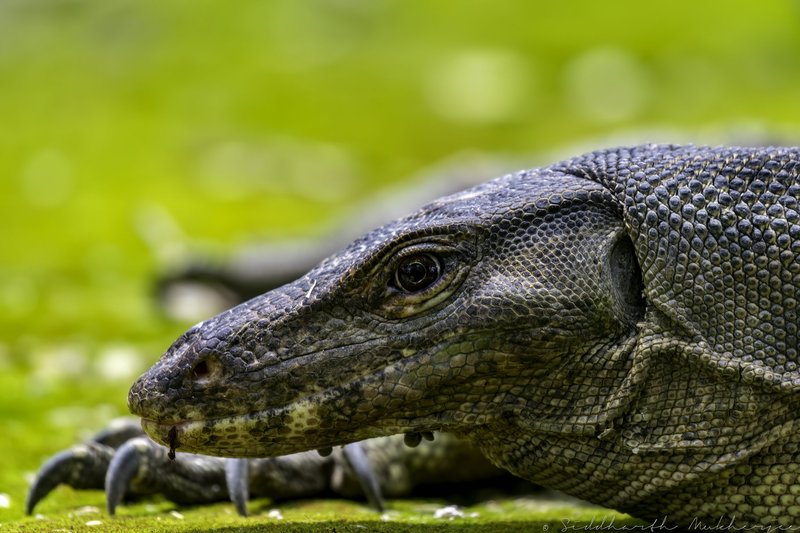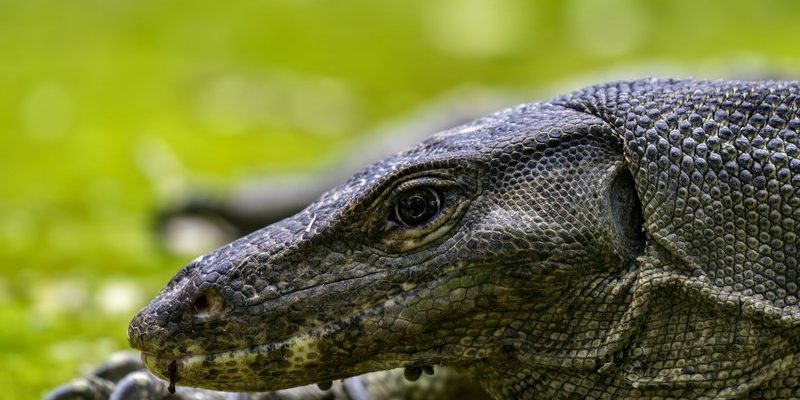
Have you ever seen a lizard that looks like it could be a mini dinosaur? That’s pretty much what the Water Monitor is! These incredible reptiles are not just any lizards—they’re agile swimmers, skilled hunters, and remarkable survivors. Found primarily in Asia and parts of Africa, water monitors can reach impressive lengths and adapt well to various habitats, especially near water sources.
Imagine strolling through a lush tropical rainforest or along a riverbank, and suddenly spotting a sleek, powerful creature sliding through the water or basking on a sunlit rock. That’s the moment you realize how captivating and unique water monitors truly are. If you’re curious about their behaviors, diets, habitats, and more, you’re in the right place!
Physical Characteristics of Water Monitors
Water monitors are among the largest lizards on the planet. Adults can grow anywhere from 4 to 10 feet long, depending on the species and their environment. Their bodies are long and muscular, designed for both swimming and climbing. They have a distinctive, elongated tail that helps them propel through water—think of it like a powerful rudder guiding a boat!
Their skin is usually a mix of dark brown, black, and yellowish markings, providing excellent camouflage among the dappled sunlight of their habitat. This coloration isn’t just for show; it helps them blend in with the forest floor or the muddy banks of rivers, making it easier for them to sneak up on prey or evade predators.
One of the most intriguing aspects of the water monitor is its sharp claws and strong jaws. These adaptations allow them to dig, climb, and hunt effectively. Interestingly, they also have a keen sense of smell, which plays a vital role in locating food and mates. In fact, they can detect scents from quite a distance, making them formidable hunters.
Habitat and Range
Water monitors thrive in tropical and subtropical regions, favoring environments close to water sources. You might find them lounging by rivers, lakes, mangroves, or even in urban settings near canals and ponds. Their adaptability is impressive; they can cope with changing environments, whether it’s a dense jungle or a more sparsely vegetated area.
In Asia, they are found in countries like Indonesia, Malaysia, and Thailand. In Africa, their range extends to parts of Nigeria and other coastal regions. The water monitor’s ability to swim proficiently enables them to traverse various waterways, which is crucial for their survival and hunting strategies.
These lizards are also known to dig burrows in banks, providing them shelter from extreme weather conditions and a safe place to lay their eggs. They often bask in the sun on exposed rocks, and if they feel threatened, they can swiftly retreat back to the safety of the water.
Diet and Hunting Behavior
As opportunistic feeders, water monitors have a pretty diverse diet. They’re primarily carnivorous, munching on anything from fish and frogs to small birds and mammals. If you’ve ever seen one hunting, it’s quite a spectacle! They use a mix of stealth and speed to catch their prey, often lurking just beneath the water’s surface until they can strike.
What’s fascinating is that they’re not just limited to aquatic diets. Water monitors will also scavenge and eat carrion, making them versatile eaters capable of thriving in different environments. You might even find them raiding nests for eggs—an easy feast for these clever lizards!
During the hunt, their sharp claws help them grip slippery surfaces, while their powerful tails can be used for balance or to deliver a warning to potential threats. This hunting prowess, combined with their keen senses, truly makes the water monitor a remarkable predator in its ecosystem.
Reproduction and Lifespan
When it comes to breeding, water monitors have interesting rituals. They typically mate during the warmer months, with females laying eggs in burrows or hidden areas near water. A single clutch can consist of up to 20 eggs, depending on the species. After laying, the mother may guard the nest, but once the eggs hatch, the young are left to fend for themselves—talk about a tough start!
The incubation period can vary but generally lasts around 3-4 months. Once the hatchlings emerge, they are miniature versions of their parents, fully equipped to start hunting small insects or fish. Young water monitors are especially vulnerable to predation, so they often seek cover in vegetation or retreat to the water until they grow larger and more capable of defending themselves.
In terms of lifespan, water monitors can live up to 10-15 years in the wild, and even longer in captivity with proper care. Their adaptability, strong instincts, and resourcefulness contribute to their longevity and success in diverse environments.
Conservation Status
Like many wildlife species, water monitors face threats from habitat loss and illegal trade. Due to their striking appearance and unique behaviors, they are sometimes targeted for the pet trade, resulting in population declines in some regions. Although they often inhabit protected areas, illegal hunting and habitat destruction remain ongoing concerns.
Conservation efforts are essential to ensure that water monitor populations remain stable. Protecting their natural habitats is crucial, as is raising awareness about the ecological importance of these lizards in their environments. Education can help people understand that water monitors are not just fascinating creatures but also vital players in maintaining ecosystem balance.
Organizations focused on wildlife conservation are working to create safer environments for these monitors, emphasizing sustainable practices that benefit both people and wildlife. By supporting these initiatives, we can help safeguard the future of water monitors and the ecosystems they belong to.
Fun Facts About Water Monitors
- Water monitors are excellent swimmers and can hold their breath for up to 30 minutes underwater.
- They have been known to reach lengths of over 10 feet, making them one of the largest lizard species.
- These lizards can run quickly on land and are just as agile in trees as they are in water.
- Water monitors are known for their intelligence, exhibiting problem-solving skills in the wild.
Water Monitor Table of Facts
| Scientific Name: | Varanus salvator |
| Average Length: | 4 to 10 feet |
| Weight: | 15 to 70 pounds |
| Diet: | Carnivorous (fish, frogs, birds, small mammals) |
| Habitat: | Near water sources (rivers, lakes, mangroves) |
| Lifespan: | 10 to 15 years in the wild |
FAQ
What do water monitors eat?
Water monitors are primarily carnivorous and enjoy a varied diet. They eat fish, amphibians, small birds, and mammals. They are also known to scavenge for dead animals, making them opportunistic feeders. This adaptability in their diet helps them thrive in various habitats.
Are water monitors dangerous to humans?
Water monitors generally avoid human interaction and are not aggressive towards people. However, they do have sharp teeth and claws, so they might defend themselves if threatened. It’s best to admire these lizards from a safe distance in their natural habitats.
How fast can water monitors swim?
Water monitors are surprisingly fast swimmers, thanks to their strong muscular bodies. They can swim at high speeds, which helps them catch prey efficiently and escape predators. Their streamlined shapes make them adept at navigating through water with finesse.
Do water monitors make good pets?
While water monitors can be kept as pets, they require special care and a suitable environment to thrive. They need ample space, a proper diet, and specific temperature and humidity levels. Potential owners should have experience with reptiles before considering one as a pet.
Where can I find water monitors?
You can find water monitors in various regions of Asia and Africa, particularly near rivers, lakes, and mangrove swamps. Places like Thailand and Indonesia are well-known habitats for these fascinating lizards. They thrive in warm climates and can also be spotted in urban areas.
Can water monitors climb trees?
Yes, water monitors are excellent climbers! They use their strong limbs and claws to navigate trees and rocky terrain. Climbing provides them with safe places to bask in the sun or escape from predators. It’s quite a sight to see these large lizards scaling tree trunks.
How long do water monitors live?
In the wild, water monitors can live up to 10 to 15 years, but they may live even longer in captivity with proper care. Their lifespan depends on factors such as diet, habitat conditions, and the presence of predators.
Are water monitors solitary or social animals?
Water monitors are generally solitary creatures, but they can sometimes be found in groups, especially during breeding season or when basking. They tend to establish territories and will often defend their space from other monitors. This territorial behavior is particularly noticeable in males.
What adaptations help water monitors survive in their environments?
Water monitors have several adaptations that aid their survival. Their strong limbs and claws allow them to climb, while their sleek bodies help them swim efficiently. Additionally, their keen sense of smell enables them to locate food and mates, and their camouflage coloration provides protection from predators.
Do water monitors have any natural predators?
Yes, despite their size and strength, water monitors face threats in the wild. Birds of prey, large snakes, and even other monitor lizards can pose a danger, especially to young hatchlings. Adult water monitors are generally safe from most predators, but they must remain vigilant to ensure their safety.

